What
critics and reviewers have said about
Ray Carney's The Films of John Cassavetes
|
Click
here for best printing of text
| The Boston
Globe “A
Cinematic Maverick” |
|
Over the past ten years,
in a torrent of essays, articles, and interviews, Ray Carney has
established himself as one of America's most brilliant and merciless
critics of the American film establishment in all of its crass commercialism—from
the producers and directors who package “star vehicles” to maximize
profitability, to the distributors and exhibitors who see to it
that the same ten titles play at every multiplex from coast to coast,
to the television, radio, and print journalists who all too often
function as mindless extensions of the studio ad campaigns. His
sharpest barbs, however, have been reserved for the academic critics
and university film programs that give Hollywood the sheen of intellectual
legitimacy by bringing its celebrities into the classroom and its
movies into the curriculum.
Of course, we've heard
much the same thing in the past decade from neo-conservative image-phobes
like Allan Bloom, William Bennett, and Hilton Kramer, all of whom
apparently equate the rise of the movies with the fall of Western
civilization. But what makes Carney's critique completely different
from theirs is that Carney, a professor of American studies and
film at Boston University, does not despise movies. His complaint,
in fact, is not that film reviewers, critics, and college teachers
take movies too seriously, but that they don't take them seriously
enough. In Carney's view, if they really cared about the art of
film, they wouldn't waste their time being trash collectors in the
ghetto of pop culture genre studies.
Yet being a nay-sayer
is too easy. The hard thing is to show how do it right, to say what
you would put in place of what you are criticizing. That is why
it is a special event, every few years or so, when Carney publishes
a book that illustrates what film study and analysis can be at their
most visionary and inspiring. Carney is clearly a born teacher,
and here as in his four previous film books his vast learning (which
takes in a wide range of American art and philosophy) and his obvious
love for his subject seem almost enough to win figures like Bloom,
Bennett, and Kramer to the cause of film study.
Every page of The
Films of John Cassavetes is informed by the passion of a man
on a mission to change the way movies are thought and written about.
Carney has an extraordinarily exalted view of the function of cinematic
art. Film is, for him, neither escapist entertainment and recreation
(as many journalistic reviewers regard it) nor an intricate stylistic
game played off to one side of life (as most film professors treat
it), but a way of exploring the most important and complex aspects
of the human experience. What he writes about Cassavetes' work here
summarizes his approach to all of the films he cares most deeply
about: “[Cassavetes'] films explore new human emotions, new conceptions
of personality, new possibilities of human relationship. He explores
new ways of being in the world, not merely new formal 'moves.' His
films are not walled off in an artistic never-never land of stylistic
inbreeding and cross-referencing. Cassavetes gives us films that
tell us about life and aspire to help us to live it.”
While most film scholars
are haggling over the date when deep focus photography was invented
or how many shots are employed in the shower sequence of Psycho,
Carney roves over the entire history of American film—from Griffith
and Capra, to Welles and Hitchcock, to Kubrick, Altman, and Allen—and
addresses ultimate questions of meaning and value. One of the most
exciting aspects of this book is the impression it conveys that
absolutely everything is open to reappraisal and revaluation. In
a series of extended analyses, Carney takes up many of the canonical
figures in American film history and offers stunningly new and controversial
reinterpretations of their work. Orson Welles's Citizen Kane
is criticized for its “rhetorical tendentiousness” and stylistic
flamboyance, and judged to be an example of “kitsch modernism.”
Hitchcock is taken to task for the “shallow mystifications,” emotional
manipulativeness, and denial of physicality in his films. Even Robert
Altman, currently the darling of many contemporary critics, is knocked
for the superciliousness, snideness, cynicism, and negativity of
his work.
Cassavetes, the no-budget,
maverick independent, is the book's heart and soul. In his characteristically
iconoclastic way, Carney argues that Cassavetes was the greatest
genius of recent cinema, and unapologetically positions his films
(which include Shadows, Faces, Husbands, Minnie
and Moskowitz, A Woman Under the Influence, The Killing
of a Chinese Bookie, Opening Night, and Love Streams)
alongside the work of many of the most important nineteenth- and
twentieth-century American writers, artists, musicians, and philosophers.
Not the least innovative aspect of Carney's writing is the degree
to which it is radically interdisciplinary, and he sketches a series
of strikingly original (yet persuasive) connections between Cassavetes'
work and that of other American artists and thinkers: Ralph Waldo
Emerson and Henry James, John Singer Sargent and Willem De Kooning,
William James and John Dewey, Louis Armstrong and Charlie Parker,
George Balanchine and Paul Taylor. Since Cassavetes' achievement
is still virtually ignored by academic film scholars, Carney is
undoubtedly aware of the apparent outrageousness of the claims and
connections he is urging. But I'm sure that is one of the reasons
he wrote the book. His goal has always been to overturn academic
apple-carts, to rock institutional boats, to gore intellectual sacred
cows.
The Films of John
Cassavetes echoes with the cadences of Emerson, one of Carney's
most resonant intellectual sounding boards. As I turned the pages,
almost holding my breath at moments, startled by the depth, power,
and unexpectedness of the argument, emotionally suspended between
exhilaration and fear, I found myself remembering one of my own
favorite Emerson quotes: “Beware when the great God lets loose a
thinker on this planet. Then all things are at risk.”
|
| The
San Francisco Review of Books
|
| “Any reader
of [The Films of John Cassavetes] will be driven to reassess
any notion they have ever held about the cinema.... Carney invites
us to be as emotionally open as Cassavetes' figures and snap out of
the Hollywood-induced trance of critical detachment in order to clear
the space between heart and mind.” |
| Newport
This Week
|
| “[The Films
of John Cassavetes] digs deeper into the soul of works by the
late John Cassavetes than anyone ever has, and it offers a challenging,
interdisciplinary approach to analyzing film form and text.... [The
Films of John Cassavetes] will, no doubt, also please the inquisitive
movie buff who seeks a well-rounded analysis of a provocative body
of work that has left an indelible mark on the American film scene.” |
| Carole
Zucker in Film Quarterly
|
| “Shortly after the
death of John Cassavetes in 1989, I organized a panel in his honor
at an upcoming Society for Cinema Studies conference. To my chagrin,
the call for papers elicited only three responses—one from noted
Cassavetes scholar Ray Carney. The incident is emblematic of the way
Cassavetes has been elided from the film studies canon, for reasons
that have as much to do with the nature of Cassavetes' films as with
the present constitution and leanings of the film studies community....
As an unrepentant auteurist, Carney asserts [in his book] that Cassavetes
“is not only one of the most important artists of the twentieth-century,
but that the originality of his work was what doomed it to critical
misunderstanding.” Carney views Cassavetes in adversarial relationship
to what he calls the “visionary/symbolic” film. By this he means
films which foster fixed, detached, intellectual ways of knowing....
The characters...have an essentially contemplative relationship and
existence....” |
| David
Sterritt in The Christian Science Monitor
|
| “Carney's
approach to Cassavetes is shaped by the depth and discipline of scholarly
analysis, and also by the out-and-out enthusiasm of a movie-lover
writing about some of his favorite pictures.” |
| The following
scholarly review of my Cambridge University Press critical study
of Cassavetes’ life and work indicates the academic marginalization
of his work that existed as recently as 1996. As far as the academy
was concerned, seven years after his death, Cassavetes was still
an almost unknown director: |
A book review by Wheeler
Winston Dixon, Professor of Film at the University of Nebraska,
Lincoln, published in The Journal of Film and Video,
vol. 48 (Spring/Summer 1996), pp. 88-94.
Carney, Ray. The
Films of John Cassavetes: Pragmatism, Modernism and the Movies (New
York and London: Cambridge University Press, 1994).
John Cassavetes’ work
as an actor in such films as The Dirty Dozen (1967), The
Fury (1978), and Rosemary’s Baby (1968)
is well known, along with his numerous appearances on television
series of the 1950s and ‘60s. What is less known is that
Cassavetes, from 1957 on, was far more interested in the work
he could accomplish as a director than as an actor.
It was as a director
that Cassavetes felt he accomplished his most important work;
as an actor, he would appear in almost anything that would
help him pay the bills to support his art, because the Hollywood
studios were unremittingly hostile to his directorial vision.
Ray Carney’s The Films of John Cassavetes: Pragmatism,
Modernism and the Movies is a long-overdue tribute to
this great artist, whose works have been generally neglected
by both the critics and the public. Meticulously researched
and superbly detailed and indexed, the book emerges as a deeply
personal and warmly engaging study of the filmmaker as an artist.
Before
his death in 1989, Cassavetes directed a series of memorable
films on shoestring budgets, starting with Shadows (shot in
1957 and released in 1958, then completely reshot and re-released
in 1989) and continuing on with Faces (shot in 1965; released
in 1968), Husbands (shot in 1969; released in 1970), Minnie
and
Moskowitz (1971), A Woman Under the Influence (shot in 1972;
released in 1974), The Killing of a Chinese Bookie (shot and
released in 1976, then recut and re-released in 1978 “in
a completely reedited” version [(Carney 314]), and Love
Streams (shot in 1983, released in 1984).
Carney argues that,
as a body of work, Cassavetes’ completely “independent” films
(as opposed to Too Late Blues, A Child is Waiting, and even Gloria [1980], to my mind the most interesting of his “studio
system” films) “participate in a previously unrecognized
form of pragmatic American modernism that, in its ebullient affirmation
of life, not only goes against the world-weariness and despair
of many twentieth-century works of art” but further, precisely
because of their unconventional structure and content, resist “the
assumptions and methods of most contemporary [film] criticism” (i)
which emphasizes formalist concerns over humanist ones.
The author cites the
directorial style of Welles, De Palma (who directed Cassavetes
in The Fury), Hitchcock, Capra, Coppola,
Griffith, and others as mechanisms of control and stylistic elegance,
as opposed to the “pseudocumentary” (77) approach
employed by Cassavetes, which used rough, hand-held camera work,
directly recorded sound, available or minimal lighting, and meditational
editing that lingered on the characters long after the tension
of a conventional “scene” was dissolved.
***
For this unconventional
approach, Cassavetes paid dearly. During the director’s
lifetime, his eight most personal films (Shadows, Faces, Husbands, Minnie
and Moskowitz, A Woman Under the Influence, Chinese
Bookie, Opening Night [shot in 1977, released
in 1978, then withdrawn and released in 1991], and Love
Streams) were ruthlessly marginalized by poor distribution
and phantom availability in 16mm or video formats. Even now, Husbands, Minnie
and Moskowitz, and Love Streams are unavailable
on videotape (28). None is available on laser disc.
This inadequate distribution
insured that the films would never reach the public at large;
confined to “art house” openings in major metropolitan
centers, Cassavetes’ films were never given the chance
to attain any kind of commercial success. But, then again,
given their problematic structure and subject matter, did Cassavetes
ever have a hope of reaching a general audience? As the director
himself observed, “All my life I’ve fought against
clarity – all those stupid definitive answers. . . .
I won’t call [my work] entertainment. It’s exploring.
It’s asking questions of people” (184). He realized
that certain
people would like a more conventional form [in cinema], much
like the gangster picture . . . they like it ‘canned.’ It’s
easy for them. They prefer that because they can catch onto
the meanings and keep ahead of the movie. But that’s
boring. I won’t make shorthand films. . . . I want to
shake [the audience] up and get them out of those quick, manufactured
truths (282).
***
This
responsive, humanly chaotic visual style is directly at odds
with conventional cinematic framing, giving the viewer
of Cassavetes’ films “unbalanced relationships,
mercurial movements, unformulated experiences slopping over
the edges of the frame, bubbling over the intellectual containers,
breaking the forms that deliver them to us” (91). Resolutely
noncommercial and anti-narrativistic in the best sense, Faces is nothing so much as a working out of Cassavetes’ view
of human fallibility as a visual as well as a situation/social
dilemma. the characters in Faces are grandiose and theatrical,
yet they are one with the audience, so ordinary and unexceptional
that we embrace them out of a common bond of shared experience.
***
In [Minnie and
Moskowitz], as in his other works, Cassavetes asks his
audience continually to revise their interpretation of both
the events and the characters they are watching on the screen
and, above all, never to become complacent viewers of the
human experience. According to Carney, this unwillingness
to rely upon cinematic convention sealed
Cassavetes’ commercial doom . . . the supreme challenge
of his work is directed at the viewer. [His audiences must]
keep tearing up each of the understandings that emerge in
the course of the film in order to remain fresh. Like the
characters, we must open ourselves to a state of not-knowing
(138).
Carney argues that
this open-endedness,
this lack of solid ground, is a fact of existence of the human
experience. Yet nearly a century of cinematic practice has
trained us to accept only the knowable, to follow a certain
trajectory, to have faith in certain patterns of narration,
to believe that events will move to a certain, predictable
closure. This reliance on the moment, this willingness to embrace
the inexpressible, to allow for the constant shifts in tone
that make up, as Cassavetes puts it, the “life . . .
[of] men and women” (139), also alienates a good number
of professional critics in their responses to his work. If
a situation can’t be trusted, then who’s to say
that any resolution of a scene is more reliable than any other?
That’s just
Carney's point here – there is no solid ground,
there is no ultimate authority. Life continually moves
away from its mooring, seeks new paths, refuses to do what
we expect (and/or desire) of it. Only in the movies can we
escape to a predictable narrative “logic.” Nor
does Cassavetes’ visual style call attention to itself
in an attempt to concretize and stabilize the narratives he
allows to unfold. As the author states:
According to Carney,
most avant-garde
films don’t arouse the degree of resistance from a viewer
or a critic that Cassavetes’ work does because they implicitly
marginalize their own insights. They stylistically contain
the dangers dramatized; they do not release them into life.
Their assaults are formal, their fragmentations are stylistic,
their disorientations are intellectual. Cassavetes moves avant-garde
imaginative disruptions off of the screen and into the world
(134).
Carney demonstrates
that for Cassavetes, it is not the practice of distanciational
cinematic technical devices that is the hallmark of his work – it
is his embrace of the erupting and unexpected narrative shifts
of existence, told in a self-effacing, nonpyrotechnical style,
that holds the viewer.
***
Carney compares The
Killing of a Chinese Bookie with Citizen Kane,
but points out a critical difference between the two films
and the aesthetic premises of the two directors:
Unlike Orson Welles’s Citizen
Kane, The Killing of a Chinese Bookie criticizes
PR forms of human relationship without collapsing into
PR forms of presentation. . . . It shows the fatuousness
of Cosmo’s quest for contentless stylishness, charm,
and elegance without itself playing the same game in its
visual and acoustic effects. . . . Welles’s work
is organized around a contradiction. He was guilty of the
very thing he indicts in his protagonist. He was in love
with stylistic razzle-dazzle. He was captive to rhetorical
flourish and grandiosity. [Cassavetes] in contrast gives
us an art devoid of gorgeousness and forms of acting that
reject melodramatic enlargements. . . . He creates an art
that repudiates stylistic virtuosity and special effects.” (230-31).
The result is a film
that is dark, murky, and altogether harrowing, a view of life
as a series of lies, manipulation, frauds, and tawdry spectacles.
At 135 minutes in its first version (1976), and even at a reduced
108 minutes in Cassavetes’ 1978 recut, the world of Chinese
Bookie is one of unrelenting nightmare, the embrace of
tinsel and flash as the emptiness that lies behind the creation
of packaged performance, Cosmo’s world is unendurable,
except that by documenting it, Cassavetes has forced us to
witness that which is simultaneously fascinating and appalling – the
death of humanism created for mass consumption.
***
As Carney demonstrates,
Cassavetes showed us the multivalent possibilities of existence
as we are forced to live them on a daily basis, without resorting
to tricky camera moves or self-conscious editing, without following
predictable narrative scenarios, instinctively eschewing the
easy way out. Cassavetes’ work exists beyond the boundaries
imposed by conventional narrative cinema – it even exists
beyond the supposed freedom of the avant-garde.
At its best, Cassavetes’ cinema
is raw, unvarnished, and deeply positive. If we can just see
things pragmatically (as the title of Ray Carney’s book
suggests), then perhaps we can live without delusion. Cassavetes’ deeply
undervalued films are the personal testament of a director
who paid for his art with his body (as an actor) and who
compromised his artistic integrity. He emerges in The Films of John
Cassavetes: Pragmatism, Modernism and the Movies as one
of the most important and essential American directors the
cinema has given us; certainly the films he directed constitute
a cultural legacy of which any creative artist would justifiably
be proud.
© Wheeler Winston
Dixon and The Journal of Film and Video. Copyright
1996. All rights reserved by the copyright holders.
|
* * *
What
young filmmakers and students have said about Ray Carney's The Films
of John Cassavetes
| “This
book changed my life. It wasn't a pretty experience, either. I argued
with it. I dismissed it. I fought it tooth and nail. But in the end,
reading this book and seeing the films it discusses represented the
single most important educational, emotional, and artistic experience
I've ever had. I tell you, the thing is a mental a-bomb. I broke down.
It literally caused me a crisis of the faith regarding everything
that I thought I knew or held dear about filmmaking, and maybe even
the world. I lost friends. Not only does this book chronicle in deep,
loving detail the films, working methods, and world-view of one of
the most important (yet underappreciated) filmmakers in American cinematic
history, it is a manifesto, articulating and illustrating an entirely
original and brain re-wiring theory of flimmaking, present in the
films of John Cassavetes; a theory at odds with 99% of the films EVER
MADE. Everything you though you knew is suspect in the glaring light
of Ray Carney's prose. Forget Citizen Kane. Forget Casablanca.
Forget Vertigo. They're like fingerpaintings next to a Picasso.
Neither lightweight nor academically verbose for its own sake, Carney's
tone is as friendly as if he were chatting with you over a beer, yet
what he says is nothing short of revolutionary. It was simple: I was
blown away. Finding precedent for Cassavetes' work in the long-standing
American Romantic tradition of Walt Whitman, Emerson, William James,
John Dewey and others, Carney's book gives film its proper due as
the greatest 20th century artform. An artform, it suggests, still
in its infancy. What Cassavetes' films did to me was simple and profound
— they showed me a new way to experience the world. A new attitude.
A new awareness. Carney did the same thing, articulating those ways,
and celebrating them with the reader. I read a lot of film books,
but this is the beat-up, dog-eared one I go back to time and time
again. No plain-Jane film text is as insightful or inspirational.
Read it and you will never be the same again. I wasn't.” |
|
—Matthew
Langdon (Mlw8330@aol.com)
|
| "I'd like to corroborate
Matthew Langdon's review (above this one). I had the advantage of
having Ray Carney as a professor at Boston University. By some stroke
of genius (probably by administrative accident), all entering film
students were required to take a survey course from him on film art
before taking anything else. Carney started with warhorses like Hitchcock's
"Psycho" and made the roomful of us (vocally) do exercises
during the screening that exposed the highly polished but rather ridiculously
superficial artifice of the "classic film". We all thought
he was crazy. Here was this man -- that one friend described as a
combination of Andy Warhol and Orville Reddenbacher -- unsubtly undermining
a number of the most globally revered films! He then paraded a host
of highly experimental films (many from the library of Congress that
practically noone outside of a Carney class has ever or will ever
see) before us that were appallingly difficult and often downright
confrontational. It's pretty safe to say that practically none of
us really "got it" until long after that semester, possibly
years. At some point I did. Carney loves film just like we all do,
however he had recognized something that we (and, most likely, you,
too) had not, that film can be so much more than anything we had imagined
(or yet been exposed to). That's largely what he wanted to show us
in this class. Film is still a nascent art, highly immature in scope
and depth. So far, Cassavetes -- one of the EASIER filmmakers Carney
introduced us to -- is one of the handful of film artists that has
done something deeply new with the form since its inception. If you
develop an interest in Cassavetes, you will find this book essential,
and you will return to it after every screening." |
|
—Martin
Doudoroff
|
| “I have
been involved in cinema for nearly 15 years. In that time I have not
placed much value in the books that have proclaimed to have such a
strong knowledge on film theory and criticism. But there is one book
that stands out for me. This book not only delves into the mind of
one of America's most brilliant filmmaker's in the last 30 years,
but also offers invaluable insight into the birth of the true independent
cinema. Raymond Carney is considered the foremost authority on Cassavetes,
and this work clearly shows his prowess in this area. Carney delves
deep into the language and imagery of this great filmmaker, showing
how his characters were constantly at the center—and not the emphasis
on great camera set-ups, or brilliant lighting. Carney gives us the
critical analysis that is so vitally needed. A great relief from the
candy-coated Pauline Kaels, Vincent Canbys, and Roger Eberts who tend
to get all the press in this area. I would highly recommend this book
to anyone who is serious about independent filmmaking.” |
|
—Christopher
Brown (cbrown@designmedia.com)
|
| “A vital
and inescapable work of film criticism. One of the best books I've
ever read about anything. A deeply resonant investigation into the
life's work of American Cinema's greatest explorer. The book faces
every major convention in film studies and with the deft precision
of its argument turns each of them on its head; it challenges the
reader to discover for themselves what film is ultimately capable
of as an examination of our lives. Heretical, unorthodox, and superbly
written. Carney is the strongest and the most imaginative film critic
in the English language.” |
|
—Christopher
Chase (chasecj@yahoo.com)
|
| “The
Films of John Cassavetes: Pragmatism, Modernism and the Movies by
Ray Carney has fundamentally changed my relationship to art. The
book
begins with the most eloquent and precise shredding of current Hollywood
filmmaking and then proceeds to give incredible insights into Cassavetes'
filmmaking methods. Each sentence paves new inroads to understanding
Cassavetes as one of the great artists of the twentieth century.
I
have learned more about acting, editing, and writing from Carney's
brilliant analysis of Cassavetes' most important films than from
any
other book (filmmaking books included). This book is absolutely essential
to anyone who is struggling with expressing our inner turmoil—as
with all watershed works it teaches you about life much more than
just the apparent topic of Cassavetes' films.” |
|
—Lucas
Sabean (lsabean@bu.edu)
|
| “Carney
offers an utterly convincing critical analysis of the great artist's
work. The author compares Cassavetes to Ralph Waldo Emerson and John
Dewey in consciousness-shifting ways useful to anyone interested in
media, culture, philosophy, and art. Now, Carney, the leading Cassavetes
expert, MUST (I hope) offer the definitive biography of this great
artist: clearly one of the most original, courageous, and mature American
filmmakers. See Cassavetes' work on video (A Woman Under the Influence
and Love Streams are absolutely wonderful; shockingly good),
and then read this book. I heartily endorse it and sincerely hope
for that definitive biography. Viva Cassavetes (and Carney)!”
|
|
—scott693@hotmail.com
from Los Angeles, June 9, 1999
|
* * *
And,
for a role-reversal, John Cassavetes on Ray Carney
(in a letter to him)
| “Energy bursts
out of your writing. I've been thinking about you. The unknown adventurer.
Blasting forth through concrete. Blast them. Then love them. Then
blast them again.... ” |
* * *
John
Cassavetes: Autoportraits
| On Ray Carney's
Autoportraits (Cahiers du Cinema) |
| “A beautiful coffee-table
sized book of b&w and color photographs of the Cassavetes' friends
and family. Also an introduction by Ray Carney. Photos by Sam and
Larry Shaw, and beautiful they are too. An expensive but essential
book. Literally do anything to own this book.....” (quoted from:
The Unofficial John Cassavetes Page ) |
* * *
Ray Carney, The Films of
John Cassavetes: Pragmatism, Modernism, and the Movies
(New York and Cambridge: Cambridge University Press, 1994), 48 illustrations,
paperback, 322 pages. This
book is available directly from the author for $20.
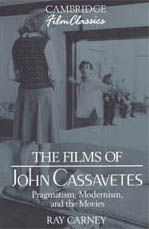
The Films of John Cassavetes tells the inside story of the making
of six of Cassavetes' most important works: Shadows, Faces,
Minnie and Moskowitz, A Woman under the Influence, The
Killing of a Chinese Bookie, and Love Streams.
With the help of almost fifty
previously unpublished photographs from the private collections of Sam
Shaw and Larry Shaw, and excerpts from interviews with the filmmaker and
many of his closest friends, the reader is taken behind the scenes to
watch the maverick independent at work: writing his scripts, rehearsing
his actors, blocking their movements, shooting his scenes, and editing
them. Through words and pictures, Cassavetes is shown to have been a deeply
thoughtful and self-aware artist and a profound commentator.
This iconoclastic, interdisciplinary
study challenges many accepted notions in film history and aesthetics.
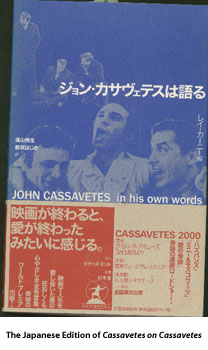 Ray Carney argues that Cassavetes' films participate in a previously unrecognized
form of pragmatic American modernism that, in its ebullient affirmation
of life, not only goes against the world-weariness and despair of many
twentieth-century works of art, but also places his works at odds with
the assumptions and methods of most contemporary film criticism. Ray Carney argues that Cassavetes' films participate in a previously unrecognized
form of pragmatic American modernism that, in its ebullient affirmation
of life, not only goes against the world-weariness and despair of many
twentieth-century works of art, but also places his works at odds with
the assumptions and methods of most contemporary film criticism.
Cassavetes' films are provocatively
linked to the philosophical writing of Ralph Waldo Emerson, William James,
and John Dewy, both as an illustration of the artistic consequences of
a pragmatic aesthetic and as an example of the challenges and rewards
of a life lived pragmatically. Cassavetes' work is shown to reveal stimulating
new ways of knowing, feeling, and being in the world.
This book is available through
Amazon,
Barnes
and Noble, your local bookseller, or, for a limited time, directly
from the author for $20 (in discounted, specially autographed editions).
See below for information how
to order this book directly from the author by money order, check, or
credit card.
Clicking on the above links
will open a new window in your browser. You may return to this page by
closing that window or by clicking on the window for this page again.
* * *
Ray
Carney, Cassavetes on Cassavetes (Faber and Faber in London,
and Farrar, Straus and Giroux in New York), copiously illustrated, paperback,
approximately 550 pages. Available directly from the author for $25.
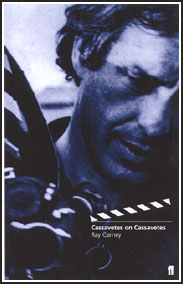 Cassavetes
on Cassavetes is the autobiography John Cassavetes never lived to
write. It tells an extraordinary saga—thirty years of film history,
chronicling the rise of the American independent movement—as it
was lived by one of its pioneers and one of the most important artists
in the history of the medium. The struggles, the triumphs, the crazy
dreams and frustrations are all here, told in Cassavetes' own words.
Cassavetes on Cassavetes tells the day-by-day story of the making
of some of the greatest and most original works of American film. —from
the “Introduction: John Cassavetes in His Own Words” Cassavetes
on Cassavetes is the autobiography John Cassavetes never lived to
write. It tells an extraordinary saga—thirty years of film history,
chronicling the rise of the American independent movement—as it
was lived by one of its pioneers and one of the most important artists
in the history of the medium. The struggles, the triumphs, the crazy
dreams and frustrations are all here, told in Cassavetes' own words.
Cassavetes on Cassavetes tells the day-by-day story of the making
of some of the greatest and most original works of American film. —from
the “Introduction: John Cassavetes in His Own Words”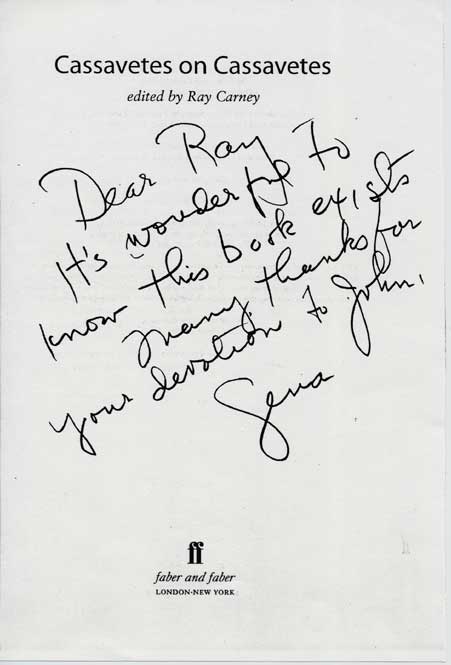
Click here to access a detailed description of the book and a summary
of the topics covered in it.
* * *
Cassavetes
on Cassavetes is available in the United States through Amazon
and Barnes
and Noble, and in England through Amazon
(UK), Faber
and Faber (UK). It is also available at your local bookseller, or,
for a limited time, directly from the author (in discounted, specially
autographed editions) for $25 via this web site. See
below for information how to order this book directly from this web
site by money order, check, or credit card (using PayPal).
* * *
Ray Carney,
John Cassavetes: The Adventure of Insecurity
(Boston: Company C Publishing, 1999), 25 illustrations, paperback, 68
pages. This book is available directly from the author
for $15.
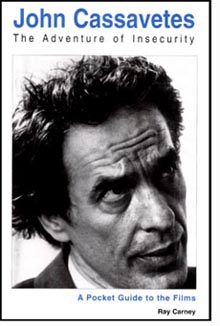 |
- New essays on all
of the major films, including Shadows, Faces,
Husbands, Minnie and Moskowitz, A Woman Under
the Influence, The Killing of a Chinese Bookie, Opening
Night, and Love Streams
- New, previously
unknown information about Cassavetes' life and working methods
- A new, previously
unpublished interview with Ray Carney about Cassavetes the person
- Statements about
life and art by Cassavetes
- Handsomely illustrated
with more than two dozen behind-the-scenes photographs
Click
here to access a detailed description of the book. |
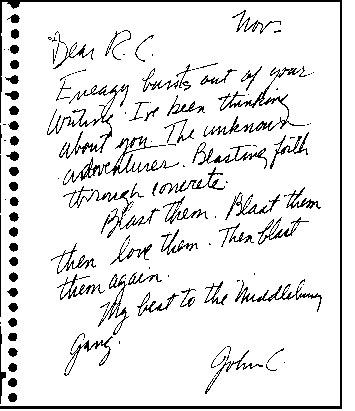 This book is
available through Amazon,
Barnes
and Noble, your local bookseller, or, for a limited time, directly
from the author for $15 (in discounted, specially autographed
editions). See below
for information how to order this book directly from the author by money
order, check, or credit card. This book is
available through Amazon,
Barnes
and Noble, your local bookseller, or, for a limited time, directly
from the author for $15 (in discounted, specially autographed
editions). See below
for information how to order this book directly from the author by money
order, check, or credit card.
Clicking on
the above links will open a new window in your browser. You may return
to this page by closing that window or by clicking on the window for
this page again.
* * *
Ray Carney,
Shadows (BFI Film Classics, ISBN: 0-85170-835-8), 88
pages. Available in the United States in August 2001. This book
is available directly from the author via this web site for $20.
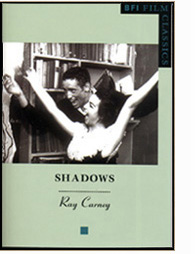
“Ray
Carney is a tireless researcher who probably knows more about the
shooting of Shadows than any other living being, including
Cassavetes when he was alive, since Carney, after all, has the added
input of ten or more of the film’s participants who remember
their own unique versions of the reality we all shared.”—Maurice
McEndree, producer and editor of Shadows
“Bravo!
Cassavetes is fortunate to have such a diligent champion. I am absolutely
dumbfounded by the depth of your research into this film.... Your
appendix...is a definitive piece of scholarly detective work.... The
Robert Aurthur revelation is another bombshell and only leaves me
wanting to know more.... The book movingly captures the excitement
and dynamic Cassavetes discovered in filmmaking; and the perseverance
and struggle of getting it up there on the screen.”—Tom
Charity, Film Editor, Time Out magazine
John Cassavetes’ Shadows is
generally regarded as the start of the independent feature movement
in America. Made for $40,000 with a nonprofessional cast and crew
and borrowed equipment, the film caused a sensation on its London
release in 1960.
The film traces the lives
of three siblings in an African-American family: Hugh, a struggling
jazz singer, attempting to obtain a job and hold onto his dignity;
Ben, a Beat drifter who goes from one fight and girlfriend to another;
and Lelia, who has a brief love affair with a white boy who turns
on her when he discovers her race. In a delicate, semi-comic drama
of self-discovery, the main characters are forced to explore who
they are and what really matters in their lives.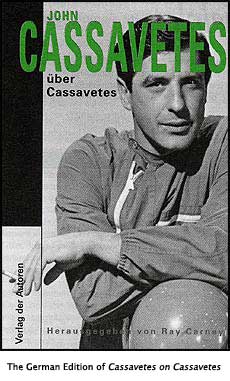
Shadows ends with the
title card "The film you have just seen was an improvisation," and
for decades was hailed as a masterpiece of spontaneity, but shortly
before Cassavetes’ death, he confessed to Ray Carney something
he had never before revealed – that much of the film was scripted.
He told him that it was shot twice and that the scenes in the second
version were written by him and Robert Alan Aurthur, a professional
Hollywood screenwriter. For Carney, it was Cassavetes‘ Rosebud.
He spent ten years tracking down the surviving members of the cast and
crew, and piecing together the true story of the making of the film.
Carney takes the reader behind
the scenes to follow every step in the making of the movie – chronicling
the hopes and dreams, the struggles and frustrations,
and the ultimate triumph of the collaboration that resulted in one of
the seminal masterworks of American independent filmmaking.
Highlights of
the presentation are more than 30 illustrations (including the only
existing photographs of the dramatic workshop Cassavetes ran in the
late fifties and of the stage on which much of Shadows was shot,
and a still showing a scene from the "lost" first version of the film);
and statements by many of the film's actors and crew members detailing
previously unknown events during its creation.
One of the most interesting and original aspects of the book is a nine-page Appendix that "reconstructs" much of the lost first version of the film for the
first time. The Appendix points out more than 100 previously unrecognized
differences between the 1957 and 1959 shoots, all of which are identified
in detail both by the scene and the time at which they occur in the
current print of the movie (so that they may be easily located on videotape
or DVD by anyone viewing the film).
By comparing
the two versions, the Appendix allows the reader to eavesdrop on Cassavetes'
process of revision and watch his mind at work as he re-thought, re-shot,
re-edited his movie. None of this information, which Carney spent more
than five years compiling, has ever appeared in print before (and, as
the presentation reveals, the few studies that have attempted to deal
with this issue prior to this are proved to have been completely mistaken
in their assumptions). The comparison of the versions and the treatment
of Cassavetes' revisionary process is definitive and final, for all
time.
This book is available through University
of California Press at Berkeley, Amazon, Barnes
and Noble, and in England through Amazon (UK)
and The
British Film Institute. For a limited time, the Shadows book
is also available directly from the author (in discounted, specially
autographed editions) via this web site. See
information below on how to order this book directly from the author
by money order, check, or credit card (PayPal). 
Clicking on the above links
will open a new window in your browser. You may return to this page
by closing that window or by clicking on the window for this page
again.
For reviews and critical
responses to Ray Carney's book on the making of Shadows, please click
here.
Ray Carney, American
Dreaming: The Films of John Cassavetes and the American Experience (Berkeley: University of California Press, 1985). $20.
[From the original dust
jacket description:] John Cassavetes is known to millions of filmgoers
as an actor who has appeared in Rosemary’s Baby, The
Dirty Dozen, Whose Life Is It, Anyway?, Tempest,
and many other Hollywood movies. But what is less known is that Cassavetes
acts in these films chiefly in order to finance his own unique independent
productions. Over the past 25 years, working almost entirely outside
the Hollywood establishment, Cassavetes has written, directed, and
produced ten extraordinary films. They range from romantic comedies
like Shadows and Minnie and Moskowitz to powerful,
poignant domestic dramas like Faces and A Woman Under
the Influence to unclassifiable emotional extravaganzas like Husbands, The 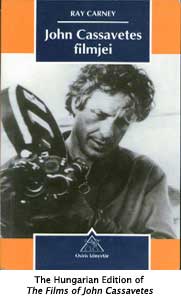 Killing
of a Chinese Bookie, and Gloria. Killing
of a Chinese Bookie, and Gloria.
This is the first book-length
study ever devoted to this controversial and iconoclastic filmmaker.
It is the argument of American Dreaming that Cassavetes
has single-handedly produced the most stunningly original and important
body of work in contemporary film. Raymond Carney examines Cassavetes’ life
and work in detail, traces his break with Hollywood, and analyzes
the cultural and bureaucratic forces that drove him to embark on
his maverick career. Cassavetes work is considered in the context
of other twentieth-century forms of traditional and avant-garde
expression and is provocatively contrasted with the better-known
work of other American and European filmmakers.
The portrait of John Cassavetes
that emerges in these pages is of an inspiringly idealistic American
dreamer attempting to beat the system and keep alive his dream of
personal freedom and individual expression – just as the characters
in the films excitingly try to keep alive their middle-class
dreams of love, freedom, and self-expression in the hostile emotional and familial environments in which they function. His films
are chronicles of the yearnings, desires, and frustrations of the
American dream. He is America’s truest historian of the inevitable conflict between the ideals and the realities of the American experience.
"By
far the most thorough, ambitious, and far-reaching criticism of Cassavetes'
work has been accomplished by Raymond Carney, currently Professor of
Film and American Studies at Boston University. Carney wrote the first
book-length study of  Cassavetes, who languished in critical obscurity
until the publication of Carney's American Dreaming in 1985....
In Carney's view, to settle the accounts of our lives, to decide once
and for all, is, for Cassavetes, to tumble headlong into the abyss
of nonentity upon which we incessantly verge. Carney argues that Cassavetes
has re-invented the craft of filmmaking in ways that drastically alter
our casual habits of film viewing. To adapt William James' terminology
(which Carney is indebted to) Cassavetes' works are concerned less
with the events and finished episodes that make up the 'substantive' parts
of our experience and more with the moments of insecurity, the 'transitive' slippages
during which our habitual strategies for understanding and stabilizing
our relationships with ourselves and others cease to function in any
useful way.... Carney's work with Cassavetes, placed within the context
of his later book, American Vision, on Frank Capra, can be viewed as
an attempt not only to further the understanding of American film,
but to forge a new synthesis of understanding in American Studies,
making his critical works valuable not only to film scholars, but to
students of American culture generally." — Lucio
Benedetto, PostScript Magazine Cassavetes, who languished in critical obscurity
until the publication of Carney's American Dreaming in 1985....
In Carney's view, to settle the accounts of our lives, to decide once
and for all, is, for Cassavetes, to tumble headlong into the abyss
of nonentity upon which we incessantly verge. Carney argues that Cassavetes
has re-invented the craft of filmmaking in ways that drastically alter
our casual habits of film viewing. To adapt William James' terminology
(which Carney is indebted to) Cassavetes' works are concerned less
with the events and finished episodes that make up the 'substantive' parts
of our experience and more with the moments of insecurity, the 'transitive' slippages
during which our habitual strategies for understanding and stabilizing
our relationships with ourselves and others cease to function in any
useful way.... Carney's work with Cassavetes, placed within the context
of his later book, American Vision, on Frank Capra, can be viewed as
an attempt not only to further the understanding of American film,
but to forge a new synthesis of understanding in American Studies,
making his critical works valuable not only to film scholars, but to
students of American culture generally." — Lucio
Benedetto, PostScript Magazine
American
Dreaming: The Films of John Cassavetes and the American Experience (Berkeley,
California: University of California Press, 1985), the first
book ever written about Cassavetes' life and work, in any language.
It has long been out of print but is now newly available through
this web site for $20 in a Xerox of the original edition. You
may order with a credit card through PayPal or through the mail
with a money order. See below.
***
In addition,
two packets of Ray Carney's uncollected essays on John Cassavetes
(material
not included in any of the above books) is also specially available
through this web site. The packet contains the texts of many of
his
notes and essays about the filmmaker. Available for $15.00.
Collected
Essays on the Life and Work of John Cassavetes (a packet of essays
by Ray Carney previously published in magazines, newspapers, and periodicals
and now unavailable). Approximately 130 pages.
A
loose-leaf bound packet of Ray Carney's writings on John Cassavetes
is specially available only through this web site. The packet has
the complete texts of program notes and essays about Cassavetes that
were published by Ray Carney in a variety of film journals and general
interest periodicals between 1989 and the present. It contains more than fifteen separate
pieces – including the keynote essay commissioned
by the Sundance Film Festival for their retrospective of Cassavetes'
work at the time of his death as well as the memorial piece on Cassavetes
awarded a prize by The Kenyon Review as "one of the best essays
of the year by a younger author."
This packet
also contains the text Ray Carney contributed to the "Special
John Cassavetes Issue" of PostScript edited by Ray
Carney, including "A Polemical Introduction: The Road Not Taken," "Seven
Program Notes from the American Tour of the Complete Films: Faces, Minnie
and Moskowitz, Woman Under the Influence, The Killing
of a Chinese Bookie, and Love Streams."
The Collected Essays
on the Life and Work of John Cassavetes is not for sale in
any store, and available exclusively on this web site for $15.00
under the same credit payment terms or at the same mailing address
as the other offers.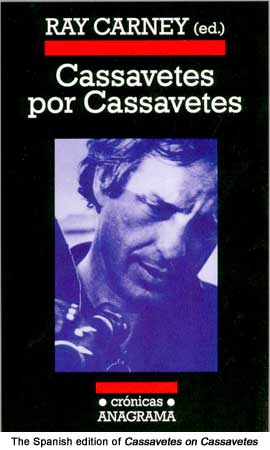
***
"Special
Issue: John Cassavetes." PostScript: Essays in Film and
the Humanities Vol. 11 Number 2 (Winter 1992). Guest editor:
Ray Carney $10.
Handsomely illustrated.
113 double-column pages (50,000 words).
A memorial tribute to the
life and work of John Cassavetes. Essays by Ray Carney, George Kouvaros,
Janice Zwierzynski, and Carole Zucker. Interviews with Al Ruban and
Seymour Cassel by Maria Viera. A history of the critical appreciation
of Cassavetes' work and a bibliography of writing in English by Lucio
Benedetto. The issue is illustrated with more than 40 behind-the-scenes
photos of Cassavetes and his actors and contains many personal statements
by him about his life and work.
This issue includes eight
essays by Ray Carney about Cassavetes' life and work: "A Polemical
Introduction: The Road Not Taken," and "Seven Program Notes
from the American Tour of the Complete Films, about Faces, Minnie
and Moskowitz, Woman Under the Influence, The Killing
of a Chinese Bookie, and Love Streams." But note
that Ray Carney's contributions to the special Cassavetes issue of PostScript magazine
are also available as part of the packet, The Collected Essays
on the Life and Work of John Cassavetes, which contains many
other pieces by Prof. Carney as well. The Collected Essays packet is listed separately above at a price of $15. But if you would like
a Xerox copy of the entire PostScript magazine issue (which
includes the other additional material by the other authors listed
above), the PostScript issue is available separately for
$10. You may order it with a credit card through PayPal or through
the mail with a money order. See the instructions below.
***
A
packet comparing the two versions of Shadows is available: A
Detective Story – Going Inside the Heart and Mind of the Artist:
A Study of Cassavetes' Revisionary Process in the Two Versions
of Shadows. Available direct from the author through this site
for $15.
This packet contains the
following material (most of which was not included in the BFI Shadows book):
- An introductory essay
about the two versions of the film
- A table noting the minute-by-minute,
shot-by-shot differences in the two prints. (In the British Film
Institute book on Shadows, this table appears in a highly
abridged, edited version, at less than half the length and detail
presented here.)
- A conjectural reconstruction
of theshot sequence in the 1957 print
- A shot list for the 1959
re-shoot of the film
- The credits exactly as
presented in the film (including typographical and orthographical
vagaries indicating Cassavetes' view of the importance of various
contributors)
- An expanded and corrected credit listing that includes previous uncredited actors and appearances (e.g. Cassavetes in a dancing sequence; Gena Rowlands in a chorus girl sequence; and Danny Simon and Gene Shepherd in the nightclub sequence)
- Notes about the running
times of both versions and information about dates and places of
early screenings
- A bibliography of suggested
additional reading (including a note about serious mistakes in
previous treatments of the film by other authors)
Very little
of this material was included in the BFI book on Shadows due
to limitations on space. This 85-page (25,000 word) packet is not
for sale in any store and is available exclusively through this site
for $15.
***
The five books, two packets,
and issue of PostScript magazine may be obtained
directly from the author, by
using the Pay Pal Credit Card button below, or by sending a check or
money order to the address below. However you order the book or books,
please provide the following information:
- Your name and address
- The title of the book
you are ordering
- Whether you would like
an inscription or autograph on the inside front cover
Checks or money
orders may be mailed to:
Ray Carney
Special Book Offer
College of Communication
640 Commonwealth Avenue
Boston University
Boston, MA 02215
|

|
Credit
Card
|
| NEW! |
| Now
you can buy Ray Carney's works online using Visa or MasterCard.
|
|
Note:
If you pay by credit card using the PayPal button, please note in
the item description or comments section of the order form the exact
title of the item or items you are ordering (be specific, since
many items have similar titles), as well as any preferences you
may have about an autograph or inscription and the name or nickname
you would like to have on the inscription.
If you are confused by the PayPal form, or unsure where to enter
this information, you may simply make your credit card payment that
way, and separately email me (at the address below) any and all
information about what item you are ordering, and what inscription
or name you would like me to write on it, or any other details about
your purchase. I will respond promptly.
The PayPal form has a place for you to indicate the number of items
you want (if you want more than one of any item), as well as your
mailing address.
If you place your order and send your payment by mail, please include
a sheet of paper with the same information on it. I am glad to do
custom inscriptions to friends or relatives, as long as you provide
all necessary information, either on the PayPal form, in a separate
email to me, or by regular mail. (Though I cannot take credit card
information by mail; PayPal is the only way I can do that.)
If you want to order other items from other pages, and are using
the PayPal button, you may combine several items in one order and
have your total payment reflect the total amount, or you may order
other items separately when you visit other pages. Since there is
no added shipping or handling charge (shipping in the US is free),
you will not be penalized for ordering individual items separately
in separate orders. It will cost exactly the same either way.
These instructions apply to American shipments only. Individuals
from outside the United States should email me and inquire about
pricing and shipping costs for international shipments.
Clicking on PayPal opens
a separate window in your browser so that this window and the information
in it will always be available for you to consult before, during,
and after clicking on the PayPal button. After you have completed
your PayPal purchase and your order has been placed, you will automatically
be returned to this page. If, on the other hand, you go to the PayPal
page and decide not to complete your order, you may simply close
the PayPal window at any point and this page should still be visible
in a window underneath it.
If you have questions,
comments, or problems, or if you would like to send me additional
information about your order, please feel free to email me at:
raycarney@usa.net.
(Note: Due to the extremely high volume of my email correspondence,
thousands of emails a week, and the diabolical ingenuity of Spammers,
be sure to use a distinctive subject heading in anything you send
me. Do NOT make your subject line read "hi" or "thanks"
or "for your information" or anything else that might
appear to be Spam or your message will never reach me. Use the
name of a filmmaker or the name of a familiar film or something
equally distinctive as your subject line. That is the only way
I will know that your message was not automatically generated
by a Spam robot.)
Problems? Unable to
access the PayPal site? If you are having difficulty, it is generally
because you are using an outdated or insecure browser. Click
here for help and information about how to check your browser's
security level or update it if necessary.
|
|










